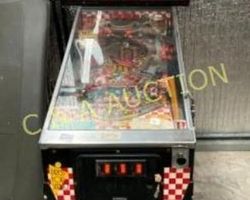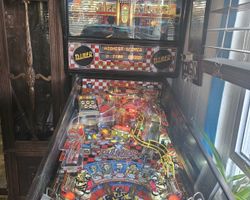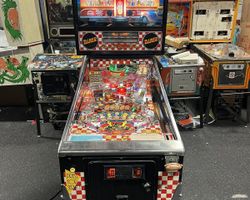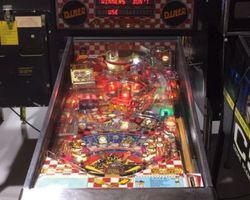Diner
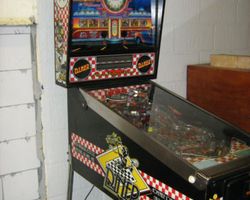
Average Prices: USD $700 to $2,800
Produced: June, 1990
Production Run: 3,552 units
Machine Type: Solid State Electronic
MPU: Williams System 11C
Players: 4
Design by: Mark Ritchie
Art by: Mark Sprenger
Music by: Chris Granner
Sound by: Chris Granner
Software by: Jim Strompolis
Step into the bustling world of chrome, checkered floors, and sizzling platters with Williams' 1990 pinball machine, Diner. Designed during a prolific period for Williams Electronics Games, Inc., Diner captures the energetic atmosphere of a classic American eatery, translating the 'rush' of serving demanding customers into frantic, rewarding pinball action. It stands as a well-regarded example of the Williams System 11C hardware generation, offering a unique theme and engaging mechanics that continue to attract players decades after its release.
History and Background: Order Up!
Manufactured by Williams in the United States, Diner rolled off the production line starting in June 1990, with its official release following in September. The machine was conceived and brought to life by a team skilled in crafting compelling pinball experiences. Mark Ritchie, known for his flow-oriented designs, led the project as the game designer. The visual identity, crucial for capturing the vibrant diner theme, was handled by artist Mark Sprenger, who filled the playfield, plastics, and backglass with colorful characters and diner motifs.
The auditory experience, a key component of the System 11 era's appeal, was developed by Chris Granner and Rich Karstens, with Granner also contributing voice callouts alongside Mark Ritchie and his brother, Steve Ritchie. Jim Strompolis handled the software programming, building the ruleset and game logic on the Williams System 11C platform. An interesting piece of trivia connects Diner to another game: it reused the "match" sequence animation code from Midway's 1989 game Mousin' Around!, which was Strompolis's first programming credit.
With a production run estimated at approximately 3,552 units, Diner wasn't produced in the massive quantities of some later Williams hits, but it found a solid place in arcades and street locations. Its accessible theme and relatively straightforward initial objectives made it approachable, while the challenging shots and multiball kept seasoned players engaged. Marketing slogans like "The Rush Is On!" and "A Full Menu of Features!" emphasized the game's fast-paced nature and thematic integration.
Signature Features and Design: The Special of the Day
Diner boasts several features that define its character. Perhaps most notable is its mechanical backbox animation, a hallmark of many Williams games from this period. Integrated into the backglass artwork are two distinct animated elements. Firstly, a large clock actively ticks, tracking the duration of the game – a clever thematic tie-in. Secondly, two diner patron figures situated in windows are mounted on springs; they physically bobble back and forth when the machine is nudged or shaken during gameplay, adding a tactile, interactive visual element.
On the playfield itself, the "Cup" shot stands out. Located centrally, this saucer mechanism requires a precise shot to lock a ball, representing serving a drink to a customer. It’s a critical shot tied directly to game progression and multiball initiation. The game also incorporates a "Cash Register" target, reinforcing the diner theme by simulating ringing up orders. These elements, combined with Sprenger's artwork, fully immerse the player in the game's world.
Playfield and Mechanics: Inside the Kitchen
Mark Ritchie's design philosophy often emphasizes smooth shot flow, and Diner reflects this, albeit with some demanding targets. The playfield layout is symmetrical in its core elements but offers distinct challenges on each side. Two main ramps dominate the upper playfield: the left ramp typically feeds the left flipper, while the right ramp returns the ball to the right flipper, allowing for continuous ramp combos if the player is accurate.
Central to the game are the five hungry customers: Haji, Babs, Boris, Pepe, and Buck. Progressing through the game involves "serving" these customers by completing specific shots. Key features include:
- Two 3-Bank Drop Target Sets: Located on the lower left and right sides of the playfield, these targets often need to be cleared to light locks or other features.
- The Cup Shot: A critical saucer target positioned mid-playfield, essential for locking balls for multiball and scoring jackpots.
- Cellar Hole: A scoop target on the upper left that awards various bonuses or advances game state.
- Spinner: Situated on the left orbit shot, rewarding fast, repeated loops.
- Pop Bumpers: A standard trio resides in the upper right, adding chaotic action.
The artwork by Mark Sprenger depicts a lively diner scene, with the five customers prominently featured on the plastics and playfield. The color palette is bright, leaning heavily on reds and yellows, evoking a sense of energy and urgency. Lighting is typical of System 11 games, using incandescent bulbs to highlight key shots and features, contributing to the warm, classic arcade feel. The overall aesthetic successfully translates the theme into a functional and visually engaging pinball environment.
Gameplay Dynamics: Handling the Rush
The core objective in Diner is to serve all five customers. Each customer is typically associated with specific shots or combinations of shots (like ramps or drop targets). Serving a customer lights their corresponding insert on the playfield. Once a customer is served, their light remains lit for the duration of the ball; players must serve them again on subsequent balls if they haven't served all five.
Completing specific objectives lights the Cup shot for "Order Up." Making the Cup shot when Order Up is lit locks a ball. Locking two balls initiates the game's primary multiball mode, "Dine Time." This is a 2-ball multiball where the main goal is to score Jackpots by shooting the Cup again. Successive Jackpot shots increase its value, creating high-scoring opportunities.
Gameplay progression revolves around systematically serving the customers. Players must strategize which customers to target based on the currently available shots and their own skill level. Completing all five customers lights a special, rewarding significant points or potentially an extra ball, depending on operator settings.
The ruleset is generally considered easy to understand: shoot lit shots to serve customers, lock balls in the cup, and score jackpots during multiball. However, mastering the shots, particularly the tight Cup shot and consistently hitting the ramps, requires skill and precision. The placement of the drop targets and outlanes can lead to frustrating drains, particularly from the right side, adding a layer of challenge and risk-reward to every shot. The game encourages flow through ramp combos but demands accuracy for the critical Cup and drop target shots.
Reception and Legacy: Still Cookin'
Upon release and throughout the years, Diner has generally received positive feedback from the pinball community. Many players praise its strong theme integration, finding the diner concept charming and well-executed through the artwork, sound design, and mechanical features like the backbox animation. The gameplay is frequently described as fun, addictive, and satisfying, especially the feeling of locking a ball in the Cup or achieving consecutive ramp shots. Its relatively simple core rules make it accessible for newcomers, yet the challenging shots provide depth for experienced players. It's often cited as a "feel-good" game, evoking nostalgia for the era and the classic theme.
However, Diner is not without its criticisms. Some players find the sound package, particularly the callouts, to become repetitive over time. While the artwork is generally liked for its thematic contribution, others find the playfield overly busy or dominated by the color red. Gameplay critiques sometimes mention that the ruleset might feel a bit shallow compared to deeper games that followed, and the scoring can feel unbalanced towards the Dine Time multiball jackpots. The tendency for balls to drain quickly, especially down the right outlane, is another common point of frustration for some.
Despite these points, Diner's legacy is secure as a popular and well-regarded System 11 title. It often draws comparisons to other Mark Ritchie designs like Taxi, with some preferring Diner for its unique theme, shot variety, and the satisfying mechanics of serving customers and hitting the Cup shot. It remains a sought-after machine for collectors due to its unique theme, engaging gameplay, and the distinctive animated backbox. Diner successfully captured a slice of Americana and translated it into an enduring pinball experience that continues to serve up fun for players across skill levels.
 Active Auctions
Active Auctions
 Auction Results
Auction Results
| Cost | Location | Date |
|---|---|---|
| USD $4,500 |  Washington, United States Washington, United States |
02 April, 2025 |
| USD $4,300 |  New Jersey, United States New Jersey, United States |
25 February, 2025 |
| USD $4,000 |  North Dakota, United States North Dakota, United States |
16 January, 2025 |
| USD $1,500 |  California, United States California, United States |
08 January, 2025 |
| USD $4,000 |  California, United States California, United States |
05 November, 2024 |
| USD $4,995 |  Montana, United States Montana, United States |
12 August, 2024 |
| USD $4,000 |  Iowa, United States Iowa, United States |
09 August, 2024 |
| USD $4,500 |  Florida, United States Florida, United States |
14 July, 2024 |
| USD $3,200 |  Florida, United States Florida, United States |
19 May, 2024 |
| USD $3,400 |  New York, United States New York, United States |
20 March, 2024 |


Private Policy · Search Website · Contact Us
All trademarks and copyrighted materials remain property of their respective owners.
All other content copyright 2007 - 2025 Pinpedia.

